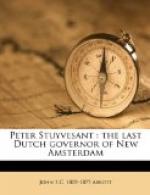“Should a Dutchman kill an Indian, or an Indian a Dutchman, no war was to be declared. A complaint was to be lodged against the murderer, who should be hanged in the presence of both the contracting parties. All damages, by the killing of cattle, were to be paid for; and this treaty was to be annually ratified by the Esopus Indians. The Hackingsack and Staten Island sachems were security for the faithful observance of this contract; and were bound to co-operate against either the Esopus Indians or the Dutch, whichever might violate its terms.”
The peace thus secured gave universal satisfaction in the Dutch settlements. Governor Stuyvesant devoutly proclaimed a day of general thanks giving to God for the great blessing.
It will be remembered that John Scott had received a commission from Connecticut, and it was expected that, as their agent, he would cause the English towns on western Long Island to be annexed to the Connecticut province. Instead of this, those towns declared themselves independent, and Scott allowed himself to be chosen their president. The Court at Hartford, upon being made acquainted with these facts, was very indignant. A proclamation was soon issued by the Assembly of Connecticut, charging Scott with various high crimes and misdemeanors, and ordering his arrest. A party of soldiers was sent under the command of John Allyn, secretary, “to seize on the body of John Scott.” Mr. Allyn returned to the Honorable Court the following interesting report of his procedure on the occasion:
“When we came within sight of the house of John Scott we saw him draw forth those men which came from New Haven to aid him, with some others, unto a body. When we came up towards the house, within twenty or thirty rods thereof. John Scott commanded us, in his Majesty’s name to stand, upon our peril. John Scott charged us in his Majesty’s name, to get off from his land. John Scott desired to know what our business was.
“Then it was replied, by Nathaniel Seely, that he desired a parley. John Scott granted a parley, and we met, each of us with a couple of musketeers. Then Nathaniel Seely told him that he had come to arrest him, and read the commission unto him. When it was read Seely demanded of him whether he would surrender himself according to commission?
“John Scott replied that he would sacrifice his heart’s blood on the ground, before he would yield to him or any of Connecticut jurisdiction. With that the New Haven men answered,




